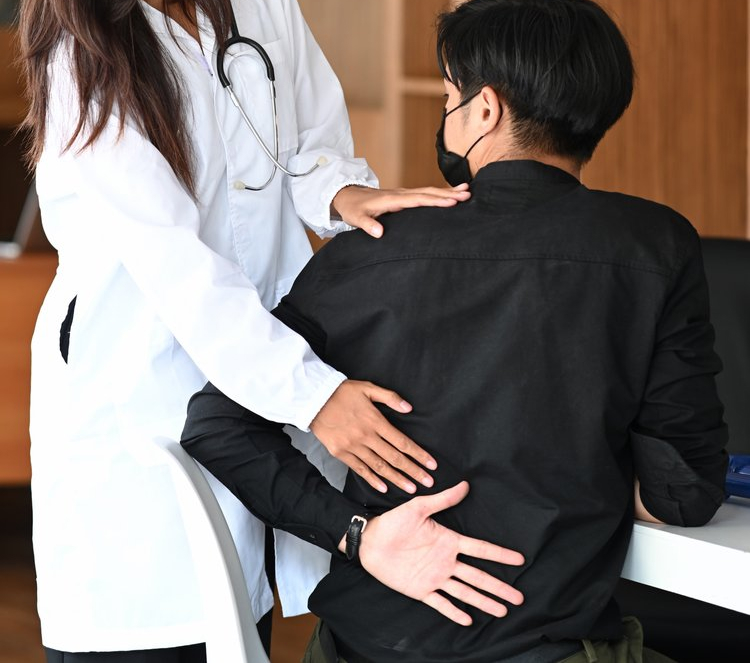If you’ve ever had lower back pain, then you know how debilitating it can be. Lower back pain is a common symptom that affects a lot of people in their daily lives. It can range from just mild occasional discomfort to severe debilitating back pain affecting your routine and sleep. This article aims to look at and address some of the common causes of lower back pain and their solutions.
What exactly is the Lower Back, anyway?
The lower back is known as the lumbar region of the spine which is part of the musculoskeletal system that allows us to move and maintain our upright posture. It consists of 5 lumbar vertebrae and is held together by intervertebral discs, ligaments, small joints, and their capsules and muscles. Nerves run within the spinal canal and leave at every level of the lumbar spine to supply the groin and lower limbs. Due to its complex nature, back pain can be multifactorial and treatment requires accurate diagnosis.
What are the more common (and less severe) causes of Lower Back Pains?
Oftentimes, lower back pain is the result of minor injuries that are a normal part of daily life. Those causes include:
- Back Sprains and Strains: The result of poor posture or ergonomics while lifting or pulling. Whether it’s stiff and tense or achy and stabbing, back pain can make it hard to focus on your job.
- Prolonged Positions: Routine office work and work-from-home arrangements, where prolonged postures are involved, can give rise to or worsen back pain. Think sitting at a desk while peering down at a smaller screen, or sitting cross-legged on the floor slouched over a computer on the living room coffee table. These can place significant demands on your back that may lead to injury and pain. Common habits such as looking down at your screen, desk tipping your head forward, or even holding a phone to your ear, may put a strain on the muscles of your neck and back after a while.
What makes “Good Posture”?
One of the most common pieces of advice given to sufferers of back pain might be to “pay attention to your posture”. The question though, is what constitutes “good posture”?
Simply put, posture is the position in which you hold your body while standing, sitting, or lying down. Good postures are body positions that place the least strain on muscles and ligaments while you are moving or performing weight-bearing activities, and a position that promotes an anatomically neutral position. This means that it does not place undue stress on any of your joints — although you may have some amount of back pain regardless!
So, why are people still faced with lower back pains despite having a good posture? Evidence [1] demonstrates that intuitive factors such as an uneven posture, slouching, and lower back hyperextension have the same likelihood of developing back pain as others with “better” posture. Currently, there is no science backing up the perfect posture theory, and static posture by itself doesn’t tell us much. Therefore, perhaps it’s time that we should shift our focus away from searching for the “best” posture, but rather, bring our attention to how much time we actually spend on each posture that we assume. In fact, if you have a history of lower back pain, then making some simple changes to your daily routine and work environment can help prevent future flare-ups. Here are some tips on how to avoid lower back pain:
1. Examine your work environment
Be it at the office or at home, address situations that might aggravate your back.
2. Ask yourself how much time do you spend stationary in those situations or positions
Many may think that sitting down at the desk all day is bad for the back, but it is not actually the sitting position but the lack of movement that is detrimental. The joints in our body crave regular movement, like how most of us naturally raise our arms up overhead to stretch when we wake up in the morning, as it helps to lubricate the many joints that make up our lower back (vertebral segments).
3. Take a short break from work every 20-30mins to do a light stretch or take a short walk (around the house if you are working from home)
As the saying goes, the best posture is the next posture, don’t let your body adapt to one specific position for long periods of time.
5. Avoid any position temporarily if it is contributing to someone’s existing symptoms
What are some less invasive or noninvasive Back Pain Treatments?
People suffering from lower back pain have many different treatment options. Some of the more common non-surgical treatments for this condition include:
- Analgesic medications like paracetamol, ibuprofen or Tylenol
- Nerve root injections can help to localise and provide longer pain relief for nerve compressions
- Facet injections can help pain arising from facet joints of the spine
- Physiotherapy
- Stay active
- Strengthen and build up your lower back to be resilient to many different positions
- Heat or hot bath
- Massage
What are the other more severe causes of Lower Back Pain?
While lower back pain can be caused by many things, there are a few more severe causes to take note of:
- Degenerative lumbar spine conditions
- Intervertebral disc disease
- Traumatic spinal injuries or fractures
- Spine tumours, infections, or even vascular malformations of the spine
- Ankylosing spondylitis (stiffness and lower back pain)
Some of the red flags for back pain include:
- Unremitting back pain after fall not responding to rest or over-the-counter pain medications
- Back pain and severe shooting pain down to legs together with weakness or numbness
- Difficulty in the control bowel movement or the passing of urine
- Severe back pain and unexplained weight loss
These conditions require a full history and physical examination in order to pinpoint the cause of the pain. Given improvements in medical imaging technologies, an MRI lumbar spine is often used to help with the diagnosis. So, if your lower back pain is accompanied by any of the following symptoms, it’s important to see a medical professional as soon as possible.
To find out more about lower back pains, schedule your next health screening with us via our Contact Us page or dial (65) 6339 1101 to book an appointment.
Reference:
G S Dieck et al. Spine (Phila Pa 1976). 1985 Dec. An epidemiologic study of the relationship between postural asymmetry in the teen years and subsequent back and neck pain.

